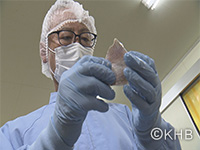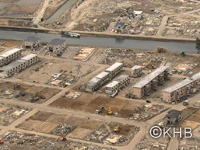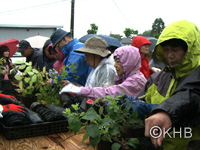TV Station KHB
Anomalies in the Sanriku Sea – Striving for Survival –
DC222326![]()
テレメンタリー2022 「三陸の海の異変 ー生き残りをかけてー」 [KHB]
![]()
![]()





|Length : 25min |Year : 2023 |
Something unusual is happening in the waters off the Sanriku coast. Fishers are catching fish from southern waters, which they have never seen before, and on the desolate seabed, countless numbers of emaciated sea urchins are crowded together on the rocks, stripped bare of seaweed. Is this really the once-abundant Sanriku coast? The reason for this devastation is the rising sea temperature due to climate change. The sea is undergoing a very serious change. Follow the fishers searching for a solution to this environmental crisis as they themselves are at the mercy of these dramatic changes.
Believe in a Brighter Future: Nature’s Recovery after The Quake
DC221219![]()
グリーンキャンペーン 豊かな未来を信じて [KHB]
![]()
![]()


|Length : 46min. |Year : 2012 |
The Great East Japan Earthquake devastated the nature along the Miyagi Prefecture coastline. Will the rich ecosystems that once existed in the bays and estuaries ever return to their original state?
This program focuses on the Miyagi coastline nature through the actions of the people working together to restore it.
The Gamo Tidal Flat was once home to a treasure trove of precious plants and animals; a wetland region spread over 11 hectares at the entrance to the Nanakita River in northern Sendai city.
The bottom feeding animals and other creatures on the flat provided sustenance for the migratory birds, as they rested on their long journey. There were more than 10 species of crabs prior to the disaster, but the population has dropped severely.
However, scenes of rejuvenation were captured, such as the birthing scene of the red-clawed crab and other chance encounters with species thought lost in the disaster.
The Japanese honey bee is a symbol of the verdant Japanese countryside.
The children of Ishinomaki city have built hive boxes from the tsunami debris. These will be set up along the Miyagi coastline by an NPO group to see whether the bees remain active in the disaster area. It's hoped that the production of honey will lead to a rejuvenated economy and job creation in the region.
In the event that they don't attract any bees, there's also another project under way which aims to replant the bees' lost habitats.
In Watari town, locals have begun their dream of rebuilding the lost tide-control forest in a century-long project. 50 participants will take on the challenge of creating a new tide-control forest 400 metres wide and 4 km long.
Their dreams are slowly revealing themselves through the planning and discussions of what shape they'd like the new forest to take. The planting will officially begin from 2015 and beyond. The future trees are now seedlings being cultivated for their future role. The goal is to plant 100,000 hardwood and 100,000 Japanese black pine trees.
Although they will not be around when the next century arrives, the participants are working hard to leave a legacy that will remain for their children in the forest project.














